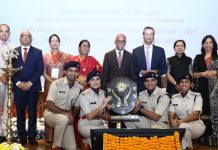 The annual athletic meet at my son’s school is a congregation of the elite, carrying an air of sophistication, flaunting their trendy outfits and greeting each other with a pleasant demeanour. For a person like me who spends more time in polishing the mind and cares less for the exterior, there is little inclination to hobnob with fellow spectators. But this year,
The annual athletic meet at my son’s school is a congregation of the elite, carrying an air of sophistication, flaunting their trendy outfits and greeting each other with a pleasant demeanour. For a person like me who spends more time in polishing the mind and cares less for the exterior, there is little inclination to hobnob with fellow spectators. But this year,
the annual event was unusual, extraordinary and inspiring. Not because of the sports and cultural extravaganza, but a chance meeting with a women of substance.
The untold story of this spirited woman having only basic education and scarce means but above all a strong determination, stirred my mind with a million thoughts of hope for a better future of girls in our country.
I occupied a corner seat in the last row in the stands of the school stadium with the seat next to mine being vacant. A young woman dressed up in a glittering saree turned up and after slight hesitation settled next to me. As she smiled coyly at me, I was charmed by her modesty. At the same time, I was intrigued by the thought of cultural dissimilarities, financial and educational divide she must be facing to pull on in a school based on the model of global learning methods.
Many questions cropped up in my mind. I could not resist. I initiated a conversation with her and learnt that her daughter happened to be my son’s classmate. I was curious to know what concessions are actually offered to the students classified under EWS (Economically Weaker Section) category. The humble lady told me that they get full fee concession on tuition fee but no relaxation on other expenses. Though the tuition fee is totally exempted, she pays through her nose the fat expenses of books, uniform, sports day dress, bus fee and sundry expenses.
Saying so, she was beaming proudly to see her girl in the midst of the ‘creamy layer’ of society. “My daughter wishes to emulate her peers and demands fancy accessories like school bag, lunch-box and water bottle, and lunch in the school cafe. Sometimes I am able to meet her demands, sometimes I have to pacify her,” the lady told me.
She said she has three daughters and all of them are studying in top-rung schools of the city. The two elder daughters are in a missionary school. The youngest wanted to study in this school and “I am trying my best to give my daughters as much as I can”, she said.
The family, with a poor economic base, also provides for the tuitions of their daughters as they are not educated enough to help them with their home assignments.
This is incredible. An uneducated young woman understands the value of girls’ education. With her limited means, she is investing in the education and learning of her daughters without giving a
second thought to saving for her old age. Not only education, but aspirations of her daughters are also important to her and she chose to put them in schools with focus on holistic development of children.
I was deeply touched to know her thoughts. Authors generally use a quote: ‘If you educate a man, you educate an individual but if you educate a woman, you educate a nation’, and this woman to my mind has put the words into practice by educating our daughters. Will she or a woman like her not be more appropriate to promote the schemes rolled out for girls’ education and women empowerment? Are these real-life heroes less than celebrity stars who are roped in at hefty fees to publicise girls’ education?
The government’s ‘Beti Padhao Beti Bachao’ programme would have got more wings if such women were associated with the promotion of the scheme who can connect with the masses with their true achievements in protecting and educating daughters.
By educating girls, we reduce poverty, improve maternal and child health, prevent HIV-AIDS, and raise the standard of living of everyone. Despite an overwhelming evidence of gains of educating a girl child, millions of school-age girls in the country are out of class. As per the 2011 census, the female literacy rate is 65.46 per cent and male literacy rate is 82.14 per cent. As per government data, the literacy rate of women in year 1951 was 8.9 per cent that reached 57 per cent in 2004. It is a significant milestone reached post-independence. But India is ranked 109 amongst 128 countries in its education index for women; this indicates that a lot more needs to be done.
The statistics on gross enrolment rate of women show that more sincere efforts need to be made to bring girls into classrooms. The number of girls per hundred boys upto class eight is 80 per cent. This declines to 70 per cent in secondary level. There is drastic fall in gross enrolment ratio for women in secondary education that is estimated at 35.8 per cent and is alarmingly low at 9.4 per cent in higher education as per a government report of 2008.
In case of preferred professional-level medical and engineering courses, women constituted only 25.1 per cent and 7 per cent of total enrolled candidates, says a UNNESCO report of 1991. The concentration of women in stereotype non-engineering, non-technical programmes such as nursing (97%), primary teaching (91%), pharmacy (28%) and secretarial practice (19%) shows the preferences of Indian society.
Indian women are expected to do household chores simultaneously with their professional responsibilities ignoring their physical and mental health. This also curtails their desire to pursue challenging professions for which they have an equal, or sometime better intellect and smartness than men. Whether organised or unorganised sector, women in India burn their candle at both the ends to give out light. Very few organisations follow the norms laid down to provide child-care facilities for employees. As the productive and reproductive years of women coincide, many women have to take career breaks to take care of babies. Many end up leaving lucrative jobs in the absence of a support system.
Those engaged in the unorganised sector can’t afford to take a break due to their economic compulsions. Constantly facing disparity of wages across sectors, women have to face many hardships at the workplace to prove themselves. While government now provides many benefits along with maternity and childcare leave of two years that can be availed over a period till the child attains the age of 18 years, these have not been incorporated by the private sector.
“No country can ever truly flourish if it stifles the potential of its women and deprives itself of the contribution of half of its citizens,” Michelle Obama has said. The time has come to introspect about the fruits of women empowerment.
Educated and financially empowered women can bring desired change in the outlook of the entire nation towards prevailing social prejudices and cultural bigotry. Education of the women is the only way to elevate the women.
letters@tehelka.com












